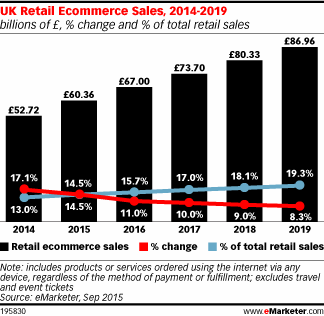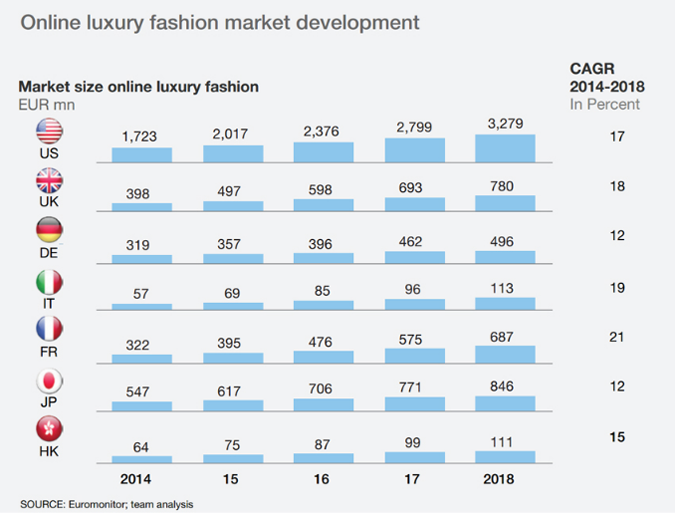The Big Luxury eCommerce Opportunity And Who’s Already Taking It
Luxury is described by the Oxford Dictionary as “a state of great comfort or elegance, especially when involving great expense”. The question on many luxury retailers lips has for some time been, can we create luxury online? Despite many convincing luxury eCommerce statistics, the luxury industry is reluctant to go online typically for the reasons of:
- Wanting to protect the feeling of luxury and exclusivity
- A belief that there is no demand for luxury online
But as one of the most stubbornly resistant luxury brands to eCommerce, Chanel, announces plans to launch eCommerce functionality in late 2016 and research continues to predict the value of luxury eCommerce will grow enormously (€70 billion by 20251), it’s time for more luxury brands to consider how they can bring their offering online.
Your Market IS there
It should come as no surprise that the eCommerce market is not to be scoffed at, particularly in the UK, with an estimated £67 billion worth of sales online in 2016!2

Image source: http://www.emarketer.com/Article/UK-Retail-Ecommerce-Sales-Reach-60-Billion-This-Year/1012963
At this point many luxury retailers may be thinking, that’s all well and good but the luxury market specifically isn’t online!
In 2014 research by McKinsey showed that only 4% of luxury sales were eCommerce sales.3 Some may interpret this as a statistic which shows there is little appetite for luxury online, conversely I believe it reflects a self-fulfilling prophecy where brands don’t provide opportunities for their audience to buy online and therefore they don’t.
Forrester analyst Sucharita Mulpuru says a real weakness of luxury brands is their failing to provide for “a lot of affluent people who are intimidated or annoyed by shopping at luxury retail stores”4. Retailers need to stop trying to force consumers down their funnel and let them shop on their own terms, especially if they intend to cater to the consumer needs in a luxury way.
Research by Euromonitor looked at the growth of the luxury fashion market across various countries. The compound annual growth rate (CAGR) between 2014-2018 in the UK is 18% and is the third biggest in this research behind France and Italy.5

Image source: http://www.mckinsey.com/industries/retail/our-insights/luxury-shopping-in-the-digital-age
This research seems to correlate with the theory that there are big growth opportunities across the entire luxury industry online.
How can an eCommerce framework be applied to luxury?
Once you accept that there is a demand for luxury products online, the next step is to assess how you can provide a luxury experience which will protect your valuable brand and provide consumers with the great comfort and elegance that defines luxury.
Many retailers (not just those in the luxury industry) make the mistake of thinking that Amazon defines the framework for eCommerce. Naturally Amazon’s approach is largely unsuitable for luxury brands, with Amazon’s focus on one click buy, limited photography or product experience and no service for the customer. Working in digital marketing, you often need to tell people that Amazon’s approach is great for Amazon but it’s not a formula for success across eCommerce. Nicolas Zurstrassen compares Amazon’s approach to letting your operations department run your offline store.6
Luxury eCommerce success story: NET-A-PORTER, the poster child for designer online
NET-A-PORTER have succeeded in offering luxury fashion, without discounts. The success of the fashion brand is down to many factors which create the feeling of luxury online:
- Seamless Multi-Channel integration offering an easy and convenient way to purchase or browse across devices
- Putting user experience at the heart of website design, product photography and packaging
- Offering editorial content to show products to their full potential through their own glossy high fashion magazine The Edit

Image source: Leather fashion fashionista via Flickr cc
They must be doing something right because in 2015 the Net-A-Porter Group announced record sales. Revenues had risen 22.8pc to £654m in the year to March, while the group reached £11m profit.7
Luxury eCommerce innovator: Burberry, blazing a trail in digital
Burberry recently announced a big shake up in their strategy where as of September 2016, clothes featured in Burberry’s runway shows will be available to buy immediately instore and online.

Image source: Wikimedia commons
This move towards immediacy puts the consumer in the driver’s seat. Sarah Mower, Vogue’s chief critic and the British Fashion Council’s ambassador for emerging talent describes Burberry’s innovation in the buying process “It’s been the critics reporting, and the buyers responding to that,” added Mower “Now the consumer is the critic.”8
This “see now, buy now” strategy redefines the traditional structure where clothes would take four months to make it from the catwalk to stores (and perhaps never online). This aligns with Burberry’s recent social media strategy where the brand offered previews of the SS16 catwalk show on Snapchat prior to the show. Because of course, there’s not just opportunities for luxury brands to sell to their audience online, there’s also big opportunities to engage with their audience.
Summary
With the luxury eCommerce market predicted to grow to €70 billion by 2025 it’s long overdue for luxury retailers to ask themselves: why are only 4% of luxury sales eCommerce? The stats show huge opportunities for luxury online, but how will luxury brands take the next step to bring luxury online and expand into this largely untapped market place?
Thanks for reading
If you have enjoyed reading about luxury eCommerce trends and stats, follow my contributions to the ThoughtShift blog for more eCommerce trends and consumer insights, or why not sign up for our Guest List email to make sure you never miss a thing.
Sources
- https://www.mckinsey.de/sites/mck_files/files/dle-2015-global-report.pdf
- http://www.emarketer.com/Article/UK-Retail-Ecommerce-Sales-Reach-60-Billion-This-Year/1012963
- http://www.mckinsey.com/industries/retail/our-insights/luxury-shopping-in-the-digital-age
- http://www.bloomberg.com/bw/articles/2014-04-03/luxury-brands-should-sell-their-products-online
- https://www.mckinsey.de/sites/mck_files/files/csi_online_luxury_fashion.pdf
- http://luxurysociety.com/articles/2016/01/opinion-why-are-luxury-brands-cowards-online
- http://www.telegraph.co.uk/finance/newsbysector/retailandconsumer/11674046/Net-a-Porter-announces-record-sales-following-merger.html
- http://www.theguardian.com/business/2016/feb/05/burberry-ditching-of-seasonal-catwalks-signals-fashion-shakeup
